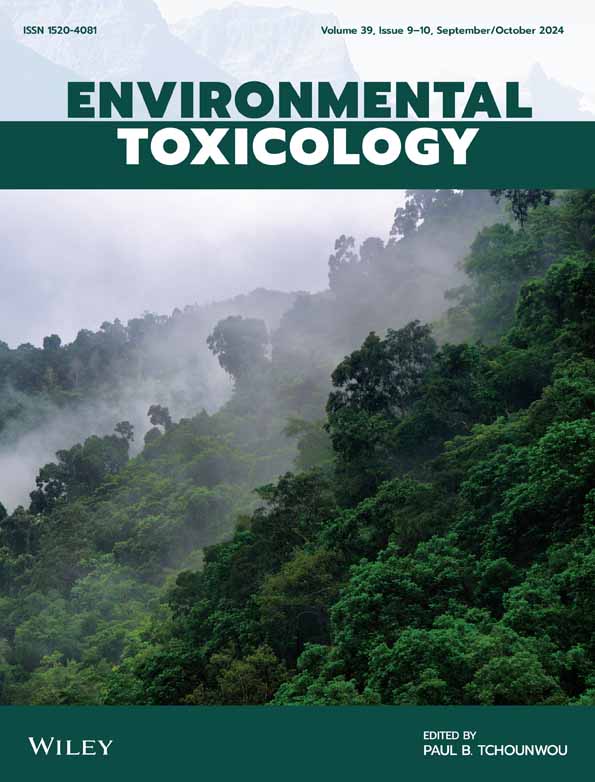Safranal对百草枯致大鼠急性肺损伤的保护作用。
IF 3.2
3区 医学
Q2 ENVIRONMENTAL SCIENCES
引用次数: 0
摘要
除草剂百草枯(PQ)可引起肺和多器官损伤。藏红花醛(Safranal, Saf)是藏红花中发现的主要化合物,具有多种药理特性,包括抗炎、抗氧化和免疫调节活性。与地塞米松(Dexa)相比,我们在大鼠身上研究了Saf和吡格列酮(Pio)的潜在预防作用,以评估它们减轻PQ气溶胶引起的肺损伤的功效。对照组(Ctrl)给予生理盐水气雾剂,其余6组(PQ)给予PQ气雾剂,每隔一天给予8次。PQ组在PQ暴露期间给予生理盐水(PQ)、两种剂量的Saf (Saf (L), 0.8 mg/kg/day和Saf (H), 3.2 mg/kg/day)、吡格列酮(Pio, 5 mg/kg/day)、Saf (L) + Pio或Dexa (0.03 mg/kg/day),持续16天。PQ组超氧化物歧化酶(SOD)、过氧化氢酶(CAT)、硫醇水平降低,支气管肺泡灌洗液(BALF)丙二醛(MDA)、肺组织肿瘤坏死因子(TNF-α)、白细胞介素10 (IL-10)水平、气管对甲胆碱的反应性(TR)、肺病理改变升高。除Saf (L)的几个变量外,所有治疗组均有显著改善。Saf (L) + Pio联合治疗的效果优于Saf (L)或Pio单独治疗。所有比较p值均< 0.05 ~ < 0.001。Saf和Pio显示出有希望的联合预防能力,这表明PPARγ受体在Saf的影响中起作用。本文章由计算机程序翻译,如有差异,请以英文原文为准。
Protective Effects of Safranal Against Paraquat-Induced Acute Lung Injury in Rat.
Lung and multi-organ injuries are caused by the herbicide paraquat (PQ). Safranal (Saf), the principal compound found in Crocus sativus, exhibits a diverse array of pharmacological properties, encompassing anti-inflammatory, anti-oxidative, and immunoregulatory activities. The potential preventive impacts of Saf and pioglitazone (Pio), in comparison to dexamethasone (Dexa), were investigated in rats to assess their efficacy in mitigating lung injury induced by PQ aerosol. Saline aerosol was given to the control (Ctrl) group of rats, whereas PQ aerosol was given to the other six groups (PQ), eight times every other day. PQ groups were given either saline (PQ), two doses of Saf (Saf (L), 0.8 mg/kg/day and Saf (H), 3.2 mg/kg/day), pioglitazone (Pio, 5 mg/kg/day), the combination of Saf (L) + Pio, or Dexa (0.03 mg/kg/day) during PQ exposure for 16 days. Superoxide dismutase (SOD), catalase (CAT), and thiol levels decreased, while malondialdehyde (MDA) in the bronchoalveolar lavage fluid (BALF), lung tissue levels of tumor necrosis factor (TNF-α) and interleukin 10 (IL-10), tracheal responsiveness (TR) to methacholine, and lung pathological changes were increased in the PQ group. Significant improvements were seen in all treated groups, with the exception of a few variables in Saf (L). The combination of Saf (L) + Pio had a greater effect than Saf (L) or Pio alone. All comparisons had p values < 0.05 to < 0.001. The Saf and Pio show promising combined preventative abilities, suggesting that the PPARγ receptor plays a role in Saf impact.
求助全文
通过发布文献求助,成功后即可免费获取论文全文。
去求助
来源期刊

Environmental Toxicology
环境科学-毒理学
CiteScore
7.10
自引率
8.90%
发文量
261
审稿时长
4.5 months
期刊介绍:
The journal publishes in the areas of toxicity and toxicology of environmental pollutants in air, dust, sediment, soil and water, and natural toxins in the environment.Of particular interest are:
Toxic or biologically disruptive impacts of anthropogenic chemicals such as pharmaceuticals, industrial organics, agricultural chemicals, and by-products such as chlorinated compounds from water disinfection and waste incineration;
Natural toxins and their impacts;
Biotransformation and metabolism of toxigenic compounds, food chains for toxin accumulation or biodegradation;
Assays of toxicity, endocrine disruption, mutagenicity, carcinogenicity, ecosystem impact and health hazard;
Environmental and public health risk assessment, environmental guidelines, environmental policy for toxicants.
 求助内容:
求助内容: 应助结果提醒方式:
应助结果提醒方式:


